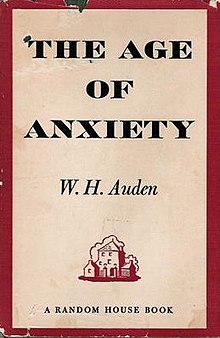The Age of Anxiety: A Baroque Eclogue (1947; first UK edition, 1948) is a long poem in six parts by W. H. Auden, written mostly in a modern version of Anglo-Saxon alliterative verse.

(publ. Random House)
The poem deals, in eclogue form, with man's quest to find substance and identity in a shifting and increasingly industrialized world. Set in a wartime bar in New York City, Auden uses four characters – Quant, Malin, Rosetta, and Emble – to explore and develop his themes.
The poem won the Pulitzer Prize for Poetry in 1948.[1]
A critical edition of the poem, edited by Alan Jacobs, was published by Princeton University Press in 2011.
Influence
editThe poem inspired Leonard Bernstein's 1949 Symphony No. 2, also known as The Age of Anxiety.
The phrase "Age of Anxiety" was used in the titles of E. R. Dodds' book Pagan and Christian in an Age of Anxiety (1965), as well as Pete Townshend's novel The Age of Anxiety (2019).[2]
References
edit- ^ "The Age of Anxiety, by W. H. Auden (Random)". The Pulitzer Prizes. Columbia University. Retrieved 28 May 2017.
- ^ Lyttle, John (7 December 2019). "Townshend's debut novel draws plenty of parallels to guitarist's rock 'n' roll lifestyle". Winnipeg Free Press. Retrieved 16 December 2019.
External links
edit- The W. H. Auden Society
- The Guardian's Book Review, 10 Apr 2010